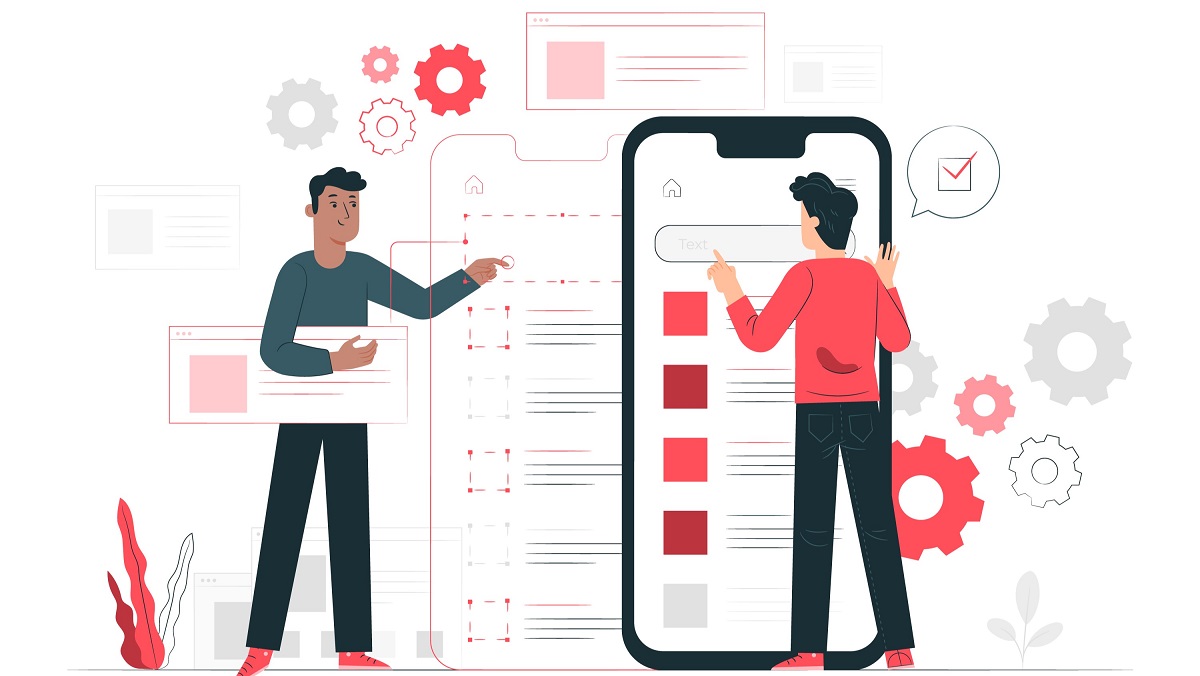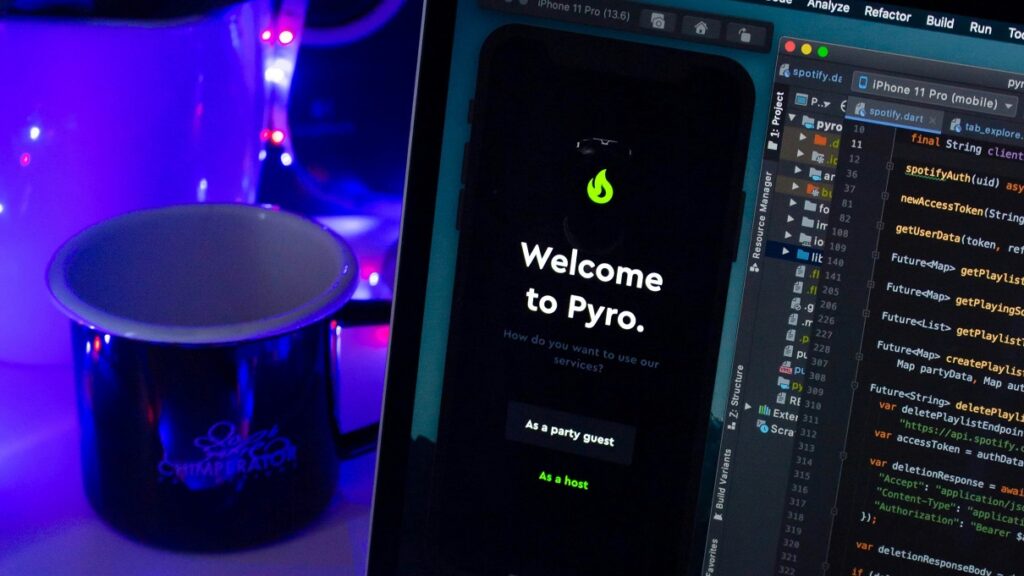Mobile App Development 101: The Ultimate Guide to Launching Your Successful App Empire

Table of Contents
I. Introduction
Imagine reaching millions of potential customers in their pockets, streamlining operations with automated workflows, and fostering unwavering brand loyalty – all through a single, powerful tool. No, it’s not magic, it’s the transformative power of mobile app development.
In today’s hyper-connected world, smartphones are omnipresent, with global app downloads expected to exceed 287 billion by 2024. This insatiable demand for mobile experiences represents an unprecedented opportunity for businesses of all sizes. Whether you’re a seasoned developer brimming with innovative ideas or a budding entrepreneur with a game-changing vision, this guide is your launchpad to unlock the true potential of mobile apps.
This comprehensive resource caters to both tech-savvy developers seeking to refine their craft and business-minded individuals eager to explore the mobile app development landscape. We’ll delve into the intricate yet rewarding world of building applications, empowering you to translate your vision into a thriving mobile reality.
So, buckle up and get ready to embark on a journey that will equip you with the knowledge and resources to transform your business through the magic of mobile app development.

II. From Brainstorm to Business: Validating Your Mobile App Idea
Every successful app starts with a spark – a need, a problem, or a unique solution waiting to be unleashed. But turning that spark into a thriving business requires strategic validation. Here’s your roadmap to transforming your brilliant idea into a mobile reality:
1. Identifying the Need:
- Brainstorming: Unleash your creativity! Explore individual needs, industry trends, and potential gaps in the market. Consider your target audience, their pain points, and how your app could alleviate them.
- Market Research: Don’t fly blind! Conduct thorough research to understand existing solutions, market size, and competitor landscape. Use surveys, interviews, and industry reports to identify opportunities and avoid reinventing the wheel.
- Competitor Analysis: Size up your rivals! Analyze their strengths, weaknesses, and user feedback to learn from their successes and avoid their pitfalls. Understand their pricing models, features, and marketing strategies to carve out your unique niche.
2. Building Your Case: Validation of the idea is the Key
- Prototyping: Don’t wait to code a full-fledged app! Create low-fidelity prototypes (think sketches, wireframes) to visualize your core features and user flow. Get early feedback from potential users to iterate and refine your idea.
- User Testing: Put your prototype to the test! Involve real users in controlled testing sessions to gather feedback on usability, functionality, and overall appeal. Their insights will be invaluable in shaping your app before significant development investment.
- Minimum Viable Product (MVP): Don’t try to boil the ocean! Develop a stripped-down MVP with core features to test core assumptions and gather real-world usage data. This lean approach allows for rapid iteration and minimizes risk before you scale up.
3. From Passion to Profit: Choosing Your Monetization Model
- In-App Purchases: Offer additional features, premium content, or virtual goods within your app for users to purchase, generating ongoing revenue.
- Subscriptions: Provide recurring access to exclusive content, services, or functionalities through monthly or annual subscription plans.
- Advertising: Integrate targeted ads within your app to earn revenue without impacting user experience. Choose wisely to avoid disrupting the flow.
- Freemium Model: Offer basic features for free, attracting a larger user base, while premium features unlock advanced functionalities for paying users.
Remember, the optimal monetization strategy depends on your target audience, app type, and value proposition. Carefully consider each option and conduct market research to identify the best fit for your app.
This is just the beginning of your mobile app development journey. Stay tuned for the next chapter, where we dive into the technical aspects of bringing your vision to life!

III. Unveiling the Building Blocks: Basics of Mobile App Development
Now that your idea is validated and monetization options explored, let’s delve into the technical world of bringing your app to life. Understanding the various building blocks is crucial for making informed decisions that impact success.
1. Choosing Your App’s DNA: Native vs. Hybrid vs. Web Apps
- Native Apps: Built specifically for each platform (Android or iOS), offering optimal performance, access to device features, and a seamless user experience. However, requires separate development for each platform.
- Hybrid Apps: Built with web technologies (HTML, CSS, JavaScript) wrapped in a native container, offering cross-platform compatibility but potentially compromising performance and device access.
- Web Apps: Run entirely within a web browser, accessible from any device, but may lack native feel and functionality.
Consider your target audience, desired features, and budget when choosing the right approach.
2. Navigating the Mobile App Development Ecosystem:
- Platforms: The two dominant players are Android (powered by Google) and iOS (powered by Apple). Each has its own development tools, languages, and app stores.
- Development Tools: Popular choices include Android Studio for Android and Xcode for iOS. These tools provide integrated environments for coding, debugging, and testing.
- Programming Languages: For native mobile app development, Java/Kotlin is used for Android and Swift for iOS. Hybrid apps typically rely on JavaScript frameworks like React Native.
3. Building the Foundation: Your Technology Stack
- Frameworks: These pre-built libraries accelerate mobile app development by offering reusable components and functionalities. Choose a framework compatible with your chosen platform and technology stack.
- APIs: Integrate external services (e.g., maps, social media) using Application Programming Interfaces (APIs) to expand your app’s capabilities.
- Backend Considerations: Every app needs a backend to store data, handle user authentication, and perform complex logic. Choose a backend solution (cloud-based or on-premise) that aligns with your requirements and scalability needs.
Remember, there’s no “one-size-fits-all” solution. Research, weigh options, and consult with experienced developers to build a tech stack that perfectly supports your app’s vision and functionality.
4. Design that Drives Engagement: UI & UX Essentials
- User Interface (UI): Focus on visual aesthetics, clarity, and intuitive navigation. Ensure your app adheres to platform-specific UI guidelines for a familiar and consistent user experience.
- User Experience (UX): Design user flows that are easy to understand, efficient, and engaging. Prioritize user needs and optimize every interaction for maximum satisfaction.
Remember, a well-designed app is not just visually appealing; it’s a powerful tool for driving user engagement and business success. By understanding these core concepts and making informed choices, you’re well on your way to building an app that truly resonates with your users.

IV. Level Up Your Skills: Learning Advanced Mobile App Development
Whether you’re a complete coding novice or a seasoned developer seeking to expand your horizons, mastering mobile app development unlocks a world of possibilities. Let’s explore the learning paths available to equip you with the skills to bring your app idea to life!
For Absolute Beginners: Building Your Foundation
- Embrace the Abundance: The Internet is your learning playground! Explore online courses on platforms like Coursera, edX, or Udemy, offering structured learning paths and project-based experiences.
- Bootcamps for a Boost: Consider intensive bootcamps for immersive learning experiences. Choose a reputable provider with career support to jumpstart your mobile app development journey.
- Bite-Sized Learning: Dive into free tutorials on YouTube channels like Traversy Media or freeCodeCamp. These bite-sized lessons are perfect for exploring specific concepts at your own pace.
- Self-Learning Savvy: Embrace self-learning with comprehensive resources like interactive documentation from official platforms (Android Developers & Apple Developers) and free e-books.
Platform Picks for Beginners: Launching Your First App
- React Native: Your gateway to cross-platform mobile app development! Learn JavaScript and React to build apps for both Android and iOS, maximizing your reach with minimal code investment.
- Flutter: Embrace Google’s offering built with Dart, known for its hot reload feature and beautiful UI capabilities.
- Ionic: Utilize web technologies (HTML, CSS, JavaScript) to build hybrid apps with a focus on performance and user experience.
Mastering the Code: Essential Programming Languages
- JavaScript: This versatile language is the core of React Native and many web-based frameworks. Hone your skills in this widely adopted language to unlock diverse development opportunities.
- Java/Kotlin (Android): For native Android mobile app development, mastering Java or its modern successor, Kotlin, is crucial. Choose resources based on your learning style and preferred approach.
- Swift (iOS): Dive into Swift, Apple’s powerful language specifically designed for iOS mobile app development. Explore official resources and community-driven tutorials to become proficient.
Seasoned Developers: Scaling Your Expertise
- Expand Your Toolkit: Delve into platform-specific languages like Kotlin for advanced Android development or SwiftUI for native iOS app development.
- Embrace Advanced Frameworks: Explore advanced frameworks like Flutter’s widget-based approach or React Native’s community-driven ecosystem for complex app needs.
- Stay Ahead of the Curve: Attend developer conferences, follow industry blogs, and actively participate in online communities to stay updated on emerging trends and technologies.
Building Your Support Network: The Power of Community
- Connect with Fellow Developers: Join online forums, participate in hackathons, and attend local meetups to connect with other developers, share knowledge, and gain valuable insights.
- Leverage Community Resources: Open-source code repositories, community-driven tutorials, and developer blogs offer a wealth of free resources and learning opportunities.
- Find a Mentor: Seek guidance from experienced developers through mentorship programs or online communities. Their insights can accelerate your learning and provide valuable feedback.
Remember, the learning journey in mobile app development is continuous. Embrace the thrill of exploration, actively seek challenges, and never stop learning. With dedication and the right resources, you can transform your app idea into a reality, shaping the future of mobile experiences.

V. From Blueprint to Reality: Planning, Building, and Launching Your App
Now that you’ve mastered the fundamentals and chosen your learning path, it’s time to translate your vision into a tangible app. In this section, we’ll delve into the exciting world of planning, mobile app development, and deployment, equipping you to bring your app to life:
1. Laying the Foundation: Planning and Prototyping
- Wireframing: Sketch out the basic structure and flow of your app using low-fidelity wireframes. Think basic shapes and lines – focus on functionality rather than aesthetics at this stage.
- Mockups: Refine your wireframes with visual design elements like colors, fonts, and icons. Create high-fidelity mockups that resemble your final app’s look and feel.
- User Testing: Involve your target audience early and often. Conduct user testing with prototypes to gather feedback on usability, intuitiveness, and overall user experience. Iterate based on their insights to ensure your app truly resonates with your users.
2. Building with Agility: The Mobile App Development Process
- Agile Methodology: Embrace an iterative approach like Agile development. Break down mobile app development into manageable sprints, allowing for continuous feedback, testing, and improvement.
- Version Control: Maintain organized code with version control systems like Git. Track changes, revert to previous versions if needed, and ensure efficient collaboration among developers.
- Code Reviews: Foster a culture of code reviews where team members analyze each other’s code, suggest improvements, and maintain high coding standards.
- Testing & Quality Assurance: Implement rigorous testing strategies throughout your mobile app development. Conduct unit testing, integration testing, and user acceptance testing (UAT) to ensure your app is bug-free and functions as intended.
3. App Store Ready: Deployment and Optimization
- App Store Requirements: Familiarize yourself with the specific requirements and guidelines of each app store (Google Play Store & Apple App Store) to ensure your app adheres to their policies.
- Submission Process: Navigate the app store submission process, carefully preparing screenshots, descriptions, and keywords to optimize discoverability.
- Marketing Strategies: Don’t just build it, market it! Utilize app store optimization (ASO) techniques, social media marketing, and influencer outreach to get your app seen by the right audience.
Remember: This is just a high-level overview. Each stage involves its intricacies and tools. Research, seek guidance from experienced developers, and leverage online resources to navigate the mobile app development process effectively.

VI. Unveiling the Power of Advanced Features: Advanced Topics for Business Apps
While mastering the core principles is crucial, incorporating advanced features can truly propel your app to the next level. Let’s explore cutting-edge functionalities that enhance user experience, drive engagement, and unlock valuable insights:
1. Location-Based Services and Geofencing: Unveiling Contextual Relevance
- Location Services: Leverage built-in GPS or Wi-Fi capabilities to offer location-aware features like weather updates, nearby recommendations, or personalized content based on user location.
- Geofencing: Define virtual boundaries and trigger actions when users enter or leave designated areas. Imagine sending targeted promotions upon entering a store or offering discounts when near competitors.
2. Push Notifications and Real-Time Communication: Engaging Users in Real-Time
- Push Notifications: Send timely alerts, updates, and personalized messages directly to users’ devices, promoting engagement and driving desired actions.
- Real-Time Communication: Integrate chat functionalities, live streaming options, or in-app messaging features to foster direct communication and community building within your app.
3. Payment Gateways and Secure Transactions: Ensuring Seamless and Secure Purchases
- Payment Gateways: Integrate secure payment gateways like Stripe or PayPal to enable in-app purchases, subscriptions, or other monetization models.
- Security: Prioritize user data security by adhering to data protection regulations and implementing robust security measures to protect financial information and transactions.
4. Analytics and Data Insights: Making Informed Decisions
- Track User Behavior: Utilize analytics tools to gain insights into user engagement, app usage patterns, and feature adoption. Identify areas for improvement and optimize your app based on real user data.
- Measure Performance: Track key performance indicators (KPIs) like conversion rates, user acquisition costs, and user lifetime value to evaluate your app’s success and make data-driven decisions.
Remember, effectively integrating these features requires careful planning, technical expertise, and adherence to best practices. Consider the specific needs of your app, target audience, and business goals when choosing and implementing advanced functionalities.

VII. Beyond Launch: Nurturing Growth and Building a Thriving Mobile App
Congratulations! You’ve successfully launched your mobile app, but the journey doesn’t end there. The true measure of success lies in sustaining user engagement, fostering a loyal community, and adapting to the ever-evolving mobile landscape. Let’s explore strategies to propel your app forward:
1. Reaching the Right Audience: Marketing and User Acquisition
- App Store Optimization (ASO): Master the art of app store visibility. Optimize your app listing with relevant keywords, captivating descriptions, and high-quality screenshots to attract organic downloads.
- Social Media Strategies: Leverage the power of social media platforms like Facebook, Instagram, and Twitter to connect with potential users, showcase your app’s features, and run targeted advertising campaigns.
- Influencer Marketing: Partner with relevant influencers in your niche to reach a wider audience and gain valuable endorsements. Utilize their reach and credibility to drive app downloads and build trust.
2. Building a Community: Cultivating Loyalty and Engagement
- Customer Support: Prioritize excellent customer support by offering multiple channels (email, live chat, social media) and responding promptly to inquiries and feedback. Remember, happy users are loyal users.
- Community Building: Foster a sense of community within your app through features like forums, user groups, or in-app chat functionalities. Encourage user interaction and build a passionate user base.
- Engagement Strategies: Keep users coming back with regular content updates, exclusive offers, gamification elements, and personalized experiences. Utilize push notifications effectively to remind users about your app and drive desired actions.
3. Scaling Your Vision: Planning for the Future
- Data-Driven Decisions: Continuously analyze your app’s performance with analytics tools. Identify areas for improvement, track user behavior, and make data-informed decisions about future mobile app development.
- Scalability Planning: As your user base grows, ensure your app’s infrastructure is scalable to accommodate increased traffic and demands. Consider cloud-based solutions for flexibility and reliability.
- Future Trends: Stay updated on emerging technologies and mobile trends. Adapt your app to evolving user preferences and integrate innovative features to maintain your competitive edge.
Remember, building a successful mobile app is an ongoing process. By consistently marketing, engaging your users, and adapting to the evolving landscape, you can ensure your app thrives in the dynamic world of mobile experiences.

VIII. Conclusion: Unlocking Your Mobile App Dream
As our journey concludes, remember the immense potential mobile apps hold for businesses of all sizes. They offer a direct line to customers, streamline operations, enhance branding, and fuel growth in an ever-connected world. Whether you’re a seasoned developer brimming with ideas or a passionate entrepreneur with a game-changing vision, this guide has equipped you with the knowledge and resources to transform your dreams into a thriving mobile reality.
Empower Yourself: Take Action!
Your mobile app development journey starts now! Here are some valuable resources to fuel your progress:
- Online Courses & Bootcamps: Explore platforms like Coursera, Udemy, or Udacity for diverse learning paths and structured courses. Consider immersive bootcamps for accelerated learning.
- Mobile App Development Resources: Dive into official documentation from Android Developers and Apple developers to master platform-specific tools and languages.
- Community & Support: Connect with fellow developers through online forums, attend meetups, and leverage open-source communities for knowledge sharing and support.
- Books & Tutorials: Expand your knowledge with comprehensive books and bite-sized tutorials on YouTube channels like Traversy Media or freeCodeCamp.
Remember: The key to success lies in dedication, continuous learning, and a willingness to embrace challenges. Don’t be afraid to experiment, seek guidance, and adapt your approach to navigate the ever-evolving mobile landscape.
Here is the link (https://rechargeinspiration.com/skills-development/) to our Skill Development page, where you can learn about the skills you require to become a successful entrepreneur.